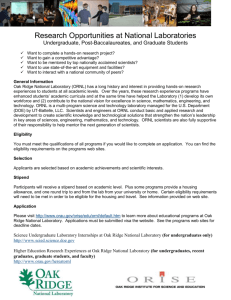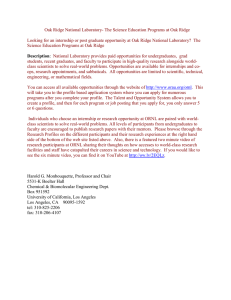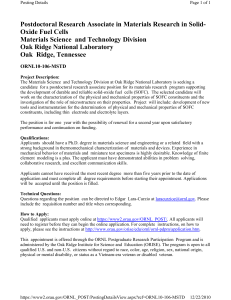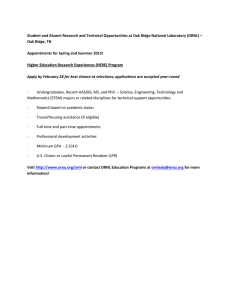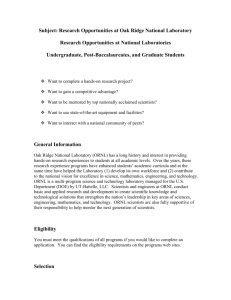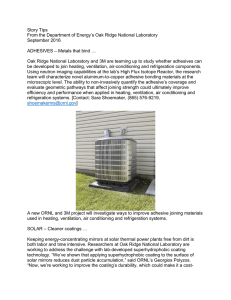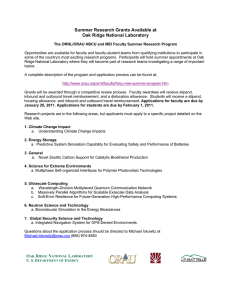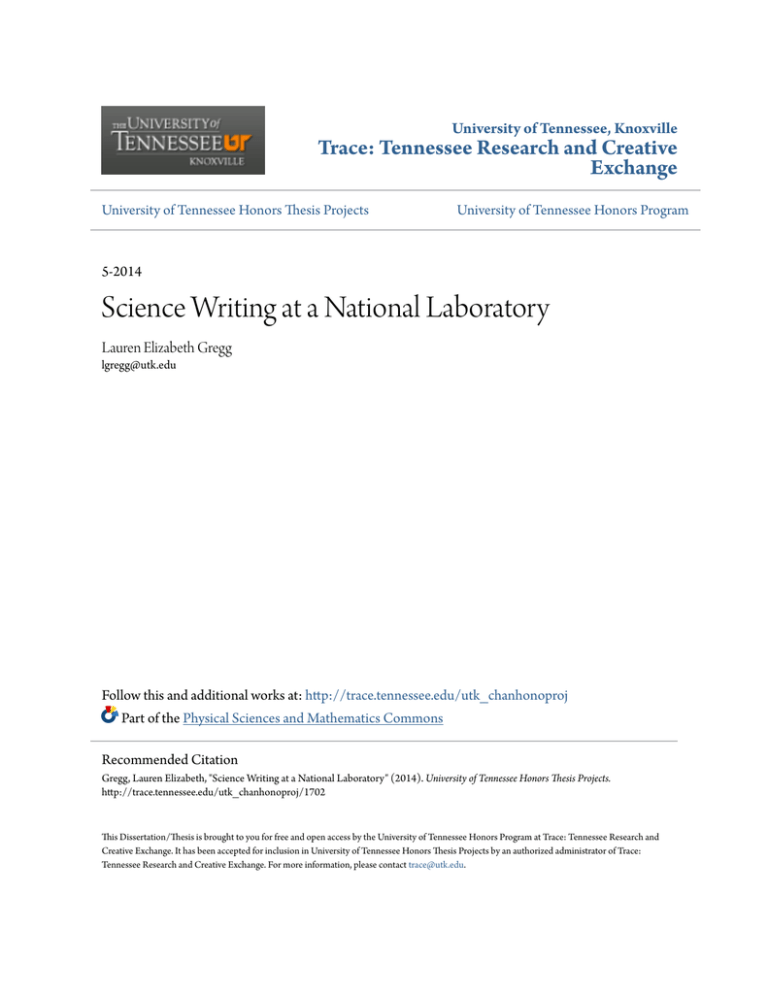
University of Tennessee, Knoxville
Trace: Tennessee Research and Creative
Exchange
University of Tennessee Honors Thesis Projects
University of Tennessee Honors Program
5-2014
Science Writing at a National Laboratory
Lauren Elizabeth Gregg
lgregg@utk.edu
Follow this and additional works at: http://trace.tennessee.edu/utk_chanhonoproj
Part of the Physical Sciences and Mathematics Commons
Recommended Citation
Gregg, Lauren Elizabeth, "Science Writing at a National Laboratory" (2014). University of Tennessee Honors Thesis Projects.
http://trace.tennessee.edu/utk_chanhonoproj/1702
This Dissertation/Thesis is brought to you for free and open access by the University of Tennessee Honors Program at Trace: Tennessee Research and
Creative Exchange. It has been accepted for inclusion in University of Tennessee Honors Thesis Projects by an authorized administrator of Trace:
Tennessee Research and Creative Exchange. For more information, please contact trace@utk.edu.
Science
Writing at a
National
Laboratory
Lauren Gregg
SCIENCE WRITING AT A NATIONAL LABORATORY
Lauren Elizabeth Gregg
A thesis submitted to the Chancellor’s Honors Program at the University of Tennessee,
Knoxville, in partial fulfillment of the requirements for the degree of Bachelor of Science in
Communications in the College of Communication and Information in the School of Advertising
and Public Relations.
Knoxville
2014
Approved by:
Mark Littmann
© 2014
Lauren Elizabeth Gregg
ALL RIGHTS RESERVED
ABSTRACT
Lauren Elizabeth Gregg: Science Writing at a National Laboratory
(Under the direction of Mark Littmann)
During the final semester of my senior year at the University of Tennessee, Knoxville, I
delved into an internship at the United States Department of Energy’s Oak Ridge National
Laboratory as a science writer. Three days a week from 8 a.m. to 4 p.m., I conducted research
and interviews to craft news releases and scientist profiles. These pieces were featured on
various platforms, including DOE publications, ORNL’s website and various Knoxville-area
newspapers—both online and print. I met a smorgasbord of successful researchers, learned about
research from all facets of the Lab and strengthened my writing skills and style. The challenging
and rewarding internship experience exposed me to the life of a writer.
TABLE OF CONTENTS
Introduction……………………………………………………………………………………….1
Scientist Profiles………………………………………………………………………………..…3
Omer Onar…...……………………………………………………………………………4
Amy Elliott...………………………………………………………………………………7
Sally Ellingson.……………………………………………………………………..……10
Science Spotlights………………………………………………………………………………..12
Bobby Sumpter…………………………………………………………………………..13
Ethan Coffey……………………………………………………………………………..14
Alan Icenhour...…………………………………………………………………………..15
Technologies……………………………………………………………………………..16
Adventures at the Lab……………………………………………………………………………18
Spring Nature Walks……………………………………………………………………..19
Controlled Fire…………………………………………………………………………...21
ORNL Today…………………………………………………………………………………….23
Conclusion……………………………………………………………………………………….27
Welcome to Oak Ridge National Laboratory
During January of my senior year at the University of Tennessee, I embarked on an
unforgettable internship. Without a lab coat, without a beaker and without safety goggles, I
arrived at the United States Department of Energy’s Oak Ridge National Laboratory. My role
here: a science writer. I dabbled in science writing the semester prior in Dr. Mark Littmann’s
“Science Writing as Literature” course, but I did not feel prepared for the internship approaching
me. As I drove down the winding roads toward ORNL, I fretted about consuming science
firsthand, asking intellectual questions and then communicating the information in an
understandable fashion. During my undergraduate career I had only taken two science courses:
botany and geology. My heart beat faster as I approached the security gates.
I parked and walked to the ORNL Visitor Center where I received my badge. I navigated
my way to Building 4500N with the campus map. Although I met the communications crew
during my initial interview, I reintroduced myself. Bill Cabage was my main contact. His wispy
gray hair and southern twang made him a personable adviser. On Fridays, he would strum his
acoustic guitar in preparation for weekend performances with his band. After I received my
ORNL email address, greggle@ornl.gov, Bill began calling me Greggle. This humorous
nickname was also used by the communications crew member in the office next door to Bill’s—
Morgan McCorkle, a previous intern at ORNL. Morgan is in her twenties and will inevitably
make you laugh with her sharp wit and cultured personality. Bill and Morgan became my lunch
buddies. We journeyed to the Lab’s cafeteria at noon Monday, Wednesday and Friday to meet
our lunch group comprised of scientists and interns from other areas of the Lab.
The rest of the communications crew includes Jim Pierce, a man with gobs of wisdom
and smiles; Ron Walli, a talkative Republican ready to share life lessons; Fred Stroehl, a curious
individual who makes a point to read each day’s obituaries; Karen Garrett, the southern secretary
with an addiction to Diet Pepsi; and David Keim, the boss man and sushi connoisseur. The crew
quickly became family. They were eager to help me find my way around ORNL, they were
happy to edit my assignments and provide suggestions, they were interested in my success.
I was assigned my own office complete with a name plate outside the door. The office’s
horseshoe-shaped desk hosted a plethora of items: newspapers, an AP Stylebook, post-it notes of
all colors, pens, a Dell computer. The office is also home to the miniature refrigerator. The
community fridge and newspapers engendered quite a bit of traffic and conversations into my
office. During my four months at ORNL, I crafted a number of pieces, including news releases,
scientist profile features and blurbs for ORNL Today, the Lab’s internal news site.
Scientist Profiles
On day one of my internship, I was assigned the project of scientist profiles. Through
internal promotional videos, press releases and ORNL’s contact and directorates system, I
compiled a list of profile candidates. After learning the family tree of divisions and titles, I made
an effort to pick a scientist from each division for a full representation of ORNL’s vast research
capabilities. The final portfolio of the scientist profiles included researchers from the Materials
Science and Technology Division, the Environmental Sciences Division, Electrical and
Electronics Systems Division, and the Energy and Environmental Sciences Division.
I sent an email to each scientist that included an introduction, the interview invitation and
a link to a sample profile. After receiving an affirmative response, I conducted background
research to contribute to specific interview questions. Armed with paper and pen, an audio
recorder and a list of interview questions, I journeyed across the campus. My first interview was
with Valentino Cooper, a cheerful researcher in the Materials Science and Technology Division.
The Bahamian native was very friendly to converse with, but the interview lacked substance. The
resulting profile was interesting, but Cooper is still in the process of sending me more
information to add to the lackluster interview.
The ensuing interviews proved to be a success. The following profiles feature Omer
Onar, a member of the team who created the world’s first wireless charging system with coils for
electric vehicles; Amy Elliott, a reality television participant and 3-D printing guru; and Sally
Ellingson, a young researcher who works with the famous supercomputers at ORNL. The Onar
profile was published in DOE Pulse, the DOE’s online publication. The other profiles will also
be featured in similar publications, as well as in ORNL’s magazine and online feature story
collection.
ORNL researcher helps create a ‘world’s first’ for electric vehicles
Media Contact: Lauren Gregg
Communications and Media Relations
865.241.9515
As a child in Istanbul, Turkey, Omer Onar told people he wanted to be an astronaut. His passion
for science evolved into a more earthly area—cars. Onar now works with power electronics and
electric vehicles in Oak Ridge National Laboratory’s Electrical & Electronics Systems Research
Division.
In fact, Onar and his team received the Energy and Transportation Science Division’s Significant
Event Award for accomplishing the world’s first dynamic wireless charging system with coils
and for winning the Department of Energy’s Funding Opportunity Announcement #667 on
“Wireless Charging of Electric Vehicles,” resulting in $11.8 million of funding over three years
through the Vehicle Technologies Office.
In stationary charging, an EV parks over a charging platform, the vehicle and unit establish a
connection and “do some handshaking” to safely initiate the wireless charging, Onar said.
“ORNL is partnering with Toyota, General Motors, Evatran, Clemson University ICAR Center,
Cisco, Duke Energy and International Rectifier. So it’s a real large group of prestigious entities
and a very good budget,” he said.
Onar received his bachelor’s and master’s degrees in electrical engineering from Yildiz
Technical University in Istanbul. During his second year of undergrad, his computer
programming professor ignited his interest in engineering. The professor was one of the only
instructors teaching MATLAB, an interactive mathematics system designed for engineering and
scientific programming.
“I was doing very well in the class,” Onar said. “He asked me and a friend, ‘I’m going to draft a
book for this area on MATLAB. Are you interested in joining me?’”
Onar agreed. The first and second editions of their book Proficiency in MATLAB became
academic bestsellers in Turkey. “That was a turning point for me,” Onar said. Under his
professor’s supervision, Onar got involved in the electrical engineering field and received his
master’s degree.
He applied to schools in the United States to for his doctorate. To make his final decision, Onar
researched the professors at the schools. Onar noticed the Illinois Institute of Technology
professor was young and completed his doctorate in two years.
“I thought he would have a lot of time to spend with his students,” Onar said. “And I can devote
myself better with a more caring professor. So I went to ITT.” He also discovered that ITT has
unique laboratory capabilities in the field of power electronics and electric machines.
With publications galore, Onar was nominated for the Transportation Electronics Fellowship, a
worldwide single award granted by the IEEE Vehicular Technology Society in 2008.
“It’s the one on the right,” Onar said, pointing at the awards on his bookcase. Next to that award
in his bookcase stands the Joseph J. Suozzi INTELEC Fellowship in Power Electronics, which
he recieved the following year.
After graduation in 2010, Onar applied to work at ORNL. “In preparation for my interview, I
came up with a couple of different systems that they could integrate: photovoltaic panels, energy
storage systems and residential buildings,” Onar said.
Onar’s impressive interview resulted in his selection for an Alvin M. Weinberg Fellowship, and
he joined the staff at ORNL a few months later.
Onar’s days at the lab revolve around EVs. Donning safety glasses and a smile, Onar introduces
the new mail delivery car, a black Toyota Prius, and its accompanying wireless charging station.
Funded by the lab’s Sustainable Campus Initiative, the installation of the wireless charging
system is set to begin this month at ORNL’s mail station.
To establish a charge, the vehicle must be in park with the doors closed. The weatherproof
wireless charging system has 90 percent efficiency.
Onar discussed three different charging approaches. First, charging an EV by simply parking
over the charging system—ideal for a garage or a parking lot. Second is opportunistic charging,
strategically placing charging systems at bus stops or at the airport.
The third approach is dynamic charging, or charging vehicles in motion. Installed under highway
asphalt or concrete, these charging stations would charge EVs as they pass over them. The
roadside vehicle sensors would identify the vehicle and battery to determine how much of a
charge to apply.
The dynamic wireless charging demonstration was funded by the ORNL Laboratory Director’s
R&D funds for the past two years. Last year, ORNL achieved the world’s first in-motion
wireless charging using electromagnetic induction resonance coupling coils. The lab also
produced a technology to smooth the pulsating power transfer from the coils.
Although he doesn’t have an electric car yet, Onar estimates that by 2020, EVs will be much
more common. Current battery technologies limit electric cars to a 75- to 100-mile range with
one charge. The wireless power transfer technology would enable unlimited range with smaller
and cost effective battery packs.
“It’s fixing the problem of range anxiety,” Onar said. “You can drive wherever you want. You’ll
sustain your charge without needing to stop and recharge your battery every couple of hours.”
Reasons for this shift to EVs and wireless charging include public health, national energy
security, dependence on foreign oil, the environment, noise pollution and economic motivation.
Driving a sedan-sized internal combustion vehicle 100 miles costs approximately $18 in
gasoline. One hundred miles in an EV would cost the driver about $3 in electricity.
Although these projects consume a good amount of Onar’s time, he still manages to enjoy
soccer, tennis and downtown Knoxville. He also hikes a lot. “Almost every weekend I discover a
new greenway,” Onar said. “Or sometimes I drive to the Smokies.”
Maybe someday soon he’ll be making the drive in an EV.
UT-Battelle manages ORNL for the Department of Energy’s Office of Science. DOE’s Office of
Science is the single largest supporter of basic research in the physical sciences in the United
States, and is working to address some of the most pressing challenges of the time. For more
information, please visit science.energy.gov.
ORNL engineer wants to use 3-D printing to make a difference
Media Contact: Lauren Gregg
Communications and Media Relations
865.241.9515
OAK RIDGE, Tenn., March 14, 2014 – Once a contestant on a reality television series, Amy
Elliott now delves into the reality of 3-D printing as a postdoc at the Department of Energy’s
Oak Ridge National Laboratory.
At ORNL, Elliott’s research focuses on improving a variety of 3-D printers. Her ultimate goal is
to develop a 3-D printer that can manufacture a smorgasbord of materials, including metals.
Elliott’s engineering interest ignited in high school while making a metal paper doll at a FIRST
Robotics Competition. The competition meshes science, technology and professional mentors to
create a “real-world engineering” competition for high school students, and the experience
awakened her creativity and mechanical engineering talents.
“I guess I had an aptitude for it,” Elliot said. “And I definitely had a passion for it.”
She received her bachelor’s degree from Tennessee Technological University in mechanical
engineering. As an undergrad, Elliott worked at NASA’s Marshall Space Flight Center, where
she developed skills in a variety of areas including precision machining, 3-D computer modeling
and project management.
Elliott then pursued her doctoral degree at Virginia Tech, where she worked in the Design,
Research and Education for Additive Manufacturing Systems (DREAMS) Laboratory.
At the DREAMS Lab, Elliott created the world’s first 3-D printing vending machine. Available
for use by Virginia Tech students, Elliott describes the DreamVendor as a “vending machine
with an infinite inventory.” The DreamVendor helped Elliot and her team crowd source and
understand what uses the public has for 3-D printing.
One Virginia Tech student used the machine to create a faucet adapter to fix the sink in his dorm.
“People are going to start thinking in terms of additive manufacturing,” Elliott said.
As a doctoral student, Elliott auditioned for Discovery Channel’s “The Big Brain Theory,” and
was selected as one of 10 finalists. She got the chance to use her expertise and creativity to solve
difficult engineering problems.
Elliot said the most helpful part of the show was understanding the role of failure.
“I used to be afraid to fail and would spend a lot of time and resources avoiding failure,” Elliott
said. “I guess that’s the natural inclination of us engineers—we don’t want to fail because people
depend on our work.”
Instead, Elliott recognized failure as a powerful learning tool—a tool that can help her learn
facets of an engineering system that she may have never predicted.
During her postdoc decision, she interviewed with both NASA and ORNL, comparing the
institutions’ atmospheres. In August 2013, she joined ORNL’s Manufacturing Demonstration
Facility.
“With thousands of visitors, there are opportunities to intersect people’s ideas with our
technology,” Elliott said. “At ORNL we are going full speed with everything.”
Elliott’s days at ORNL revolve around research to make 3-D printing machines smarter, more
robust and more energy efficient—at the same price point. Currently, 3-D printers “need a
babysitter,” Elliott said.
She envisions a desktop 3-D printer that crafts the product without requiring supervision. “I
don’t want to have to watch it, but I want to know if there’s a ‘paper jam,’” she said.
ORNL is working with 3-D printing companies to make these improvements. “We are walking
beside them and giving supplemental help,” Elliott said.
Many 3-D printing companies desire a machine that can manipulate metals, especially titanium
and copper. Traditionally, the formation of metals involved lasers and eBeams. This process has
expanded to binder jetting technology, which is a process that bonds the layers of a material to
form an object. Binder jetting is cheaper, simpler and doesn’t require heat.
ExOne, a nontraditional manufacturing company, is teaming up with ORNL to expand its
material capabilities in the field of additive manufacturing. The research goal is to increase the
fill density of 3-D printing from 94 percent to 100 percent, in addition to incorporating more
materials.
This research exposes Elliott to a number of different 3-D printers of all sizes. “I can crosspollinate what I’ve learned from each process and then create a new process,” she said.
When she’s not in her 3-D printing lab, Elliott enjoys snowboarding, hiking, camping, kayaking
and being outdoors. She also enjoys building things, especially furniture, on the weekend.
Up next on her to-do list is kinetic art. This style of art incorporates movement to
multidimensional sculptures and figures. Her passion for 3-D printing permeates her life.
Elliott wants to make an additive manufacturing process that can produce any material—“the
sky’s the limit,” she said.
From stamp molds for car manufacturing to submarine accessories for the Navy, 3-D printing
has the potential to benefit a number of industries. That’s Elliott’s favorite part about working at
the MDF. She predicts that one in five people will have a 3-D printer in their home within five
years.
“I think it’s every engineer’s dream to contribute something tangible to society,” Elliott said.
“And that’s what MDF does.”
UT-Battelle manages ORNL for the Department of Energy’s Office of Science. DOE’s Office of
Science is the single largest supporter of basic research in the physical sciences in the United
States, and is working to address some of the most pressing challenges of the time. For more
information, please visit science.energy.gov.
ORNL scientist uses math for medicine
Media Contact: Lauren Gregg
Communications and Media Relations
865.241.9515
OAK RIDGE, Tenn., Jan. 27, 2014 Sally Ellingson wants to use her knack for numbers to make
a difference. A doctoral student in the UT/ORNL graduate program, Ellingson grew up in
Satellite Beach, Fla.
She received degrees in computer science and math at a nearby university, the Florida Institute of
Technology. The high demand for math majors yields a variety of career paths. However,
Ellingson felt that something was lacking in her undergraduate work.
“I did well in my computer science and math courses, but I always wanted to feel like I was
working on an important problem,” Ellingson said.
Ellingson’s math advisor encouraged her to apply for the SCALE-IT graduate student training
program and fellowship at the University of Tennessee. The fellowship landed her in UT’s
Department of Genome Science and Technology, working in rotations and deciding which area
to pursue for her dissertation.
Through the rotations, Ellingson met her superviser, Jerome Baudry, and began research in the
UT/ORNL Center for Molecular Biophysics.
“The Center for Molecular Biophysics is simulation-based, and they do a lot of work on the
supercomputers,” Ellingson said. “I was really excited about that and wanted the chance to
continue developing my technical skills at the same time I was being involved in the science.”
Her research focuses on creating applications to use in drug discovery. “We’re developing tools
that run on the supercomputer to virtually test a large number of chemical compounds and
investigate different methodologies used in drug discovery in order to improve the process,”
Ellingson said.
Her hard work paid off. Ellingson won the American Chemical Society Chemical Computing
Group Research Excellence Award in May 2013. She is one of only 10 graduate students
worldwide to receive this award per year—the first recipient from UT.
Although her research consumes much of her day, she still makes time for family. Ellingson and
her daughter, Kyla, live in Farragut, Tennessee. She enjoys cooking and being active—her
current favorite activity is hot yoga. Her passion remains her work.
“The most fascinating thing is being involved in work that could potentially transform the
pharmaceutical industry and make it possible to create better drugs more cost efficiently,”
Ellingson said.
UT-Battelle manages ORNL for DOE's Office of Science. The Office of Science is the single
largest supporter of basic research in the physical sciences in the United States, and is working to
address some of the most pressing challenges of our time. For more information, please visit
http://science.energy.gov/.
Science Spotlights
As DOE’s largest multiprogram science and energy laboratory, ORNL has a plethora of
outstanding scientists and research capabilities. The talent and science advancements results in a
number of awards. ORNL’s Communications department recognizes these award recipients
primarily through news releases and ORNL Today.
The awarded division generally forwards the congratulations letter from Thom Mason,
the director of ORNL, to ORNL Communications. With this letter, the individual’s resume and
other relevant sources, the communications department creates a news release to be featured on
the Lab’s internal website. Knoxville newspapers and media also receive the ORNL-developed
releases.
I wrote these types of releases one to two times per week. The awards included
promotions within the Lab, Department of Energy awards, and ORNL Significant Event awards.
Although I usually didn’t have the opportunity to interview these researchers in person, I often
had phone conversations to clarify facts and any personal information to add to the piece. The
following news releases feature the variety of science spotlights—from new director positions to
excellent technologies to running in the Boston Marathon.
Sumpter named deputy director of ORNL’s Center for Nanophase Materials
Sciences
Media Contact: Lauren Gregg
Communications and Media Relations
865.241.9515
OAK RIDGE, Tenn., Feb. 3, 2014 -- Bobby Sumpter has been named deputy director of the
Center for Nanophase Materials Sciences (CNMS) at the Department of Energy’s Oak Ridge
National Laboratory.
Sumpter, an ORNL Corporate Fellow, has been Computational Chemical and Materials Sciences
group leader in the Computer Science and Mathematics Division as well as group leader for the
Nanomaterials Theory Institute at the CNMS.
Sumpter graduated from Southwestern Oklahoma State University with a major in chemistry and
minors in mathematics, physics, computer science and geology. He received his doctorate degree
in physical chemistry from Oklahoma State University in 1986.
After postdoc studies at Cornell University and the University of Tennessee, Sumpter joined
ORNL’s Chemistry Division in the Polymer Science group in 1992. He has published more than
300 papers.
Sumpter is a resident of Knoxville.
ORNL is managed by UT-Battelle for the Department of Energy’s Office of Science. DOE’s
Office of Science is the single largest supporter of basic research in the physical sciences in the
United States and is working to address some of the most pressing challenges of our time. For
more information, please visit http://science.energy.gov.
Ethan Coffey to run Boston Marathon backwards for last year’s bombing
victims
Media Contact: Lauren Gregg
Communications and Media Relations
865.241.9515
OAK RIDGE, Tenn., Feb. 6, 2014—ORNL mechanical engineer Ethan Coffey has qualified to
run in the Boston Marathon in April. There’s one catch—he plans to run the race twice. The first
time, he will run it backwards.
By running the race backwards—from the finish line to the start line—Ethan hopes to help some
victims of last year’s Boston Marathon bombing continue to move forward. His run will benefit
the Be Strong Stay Strong fund, which was set up for former University of Tennessee swimmers
Michael and Nicole Gross who were injured at last year’s marathon, along with Nicole’s sister,
Erika Brannock. These three were near the finish line while Nicole and Erika’s mother was
running in the marathon. Both sisters suffered leg injuries from the bombing.
On the day of the marathon, April 21, at 7 a.m., Ethan says he will begin running backwards
from the finish line to the start line in less than 3 hours. He plans to arrive at the start line with
about 10 minutes to rest before the official start of the race at 10 a.m. The two runs will total
52.4 miles.
Ethan has run in a 50-mile ultra race before, and he has run the Boston Marathon three times. He
ran track and cross country in high school and also ran at Carnegie Mellon University. Ethan
placed first in the Charleston Marathon on Jan. 18. He completed this 26.2-mile race in 2:34.08.
Ethan has already received about $2,000 in pledges. Additional money is being committed for
each minute he finishes the 52.4-mile run in less than 7 hours.
Before joining ORNL’s Electrical and Electronics Systems Research Division, this Fairfax, Va.
native worked as a thermodynamics, heat transfer and fluid flow instructor at the Navy Nuclear
Power Training Command in Goose Creek, South Carolina. Ethan received his bachelor of
science from Carnegie Mellon University and earned his master’s at Georgia Tech, both in
mechanical engineering.
ORNL is managed by UT-Battelle for the Department of Energy’s Office of Science. DOE’s
Office of Science is the single largest supporter of basic research in the physical sciences in the
United States and is working to address some of the most pressing challenges of our time. For
more information, please visit http://science.energy.gov.
Icenhour to lead ORNL's Nuclear Science and Engineering Directorate
Media Contact: Lauren Gregg
Oak Ridge National Laboratory Communications
(865) 241-9515 greggle@ornl.gov
OAK RIDGE, Tenn., Feb. 27, 2014 -- Alan Icenhour has been named Associate Laboratory
Director for Nuclear Science and Engineering at the Department of Energy's Oak Ridge National
Laboratory.
Icenhour will oversee ORNL’s contributions to nuclear security, isotope production and fission
and fusion research and technologies, as well as DOE’s Consortium for Advanced Simulation of
Light Water Reactors. Icenhour has served as interim associate laboratory director since
December.
Icenhour joined ORNL in 1990 and has worked in a variety of nuclear positions. Since 2008 he
directed three divisions: the Global Nuclear Security Technology Division, Fuel Cycle and
Isotopes Division and the Nuclear Security and Isotope Technology Division.
“We’re fortunate to be able to appoint someone with Alan’s broad technical expertise, strong
management experience and thorough understanding of ORNL nuclear operations,” ORNL
Director Thom Mason said.
Icenhour held a 21-month special assignment as the senior technical adviser to the National
Nuclear Security Admission’s Office of Nonproliferation Research and Development in
Washington, D.C. He also served 26 years with the U.S. Navy, retiring as a captain in 2010.
Icenhour's Navy duties included service on a nuclear-powered submarine.
He received his bachelor’s degree in nuclear engineering from North Carolina State University.
Icenhour received his master’s and doctorate in nuclear engineering from the University of
Tennessee.
Icenhour succeeds Jeff Binder, who accepted a position at the University of Illinois.
UT-Battelle manages ORNL for the Department of Energy’s Office of Science. DOE’s Office of
Science is the single largest supporter of basic research in the physical sciences in the United
States, and is working to address some of the most pressing challenges of the time. For more
information, please visit science.energy.gov.
The Federal Laboratory Consortium awards two ORNL technologies
Media Contact: Lauren Gregg
Communications and Media Relations
865.241.9515
OAK RIDGE, Tenn., Jan. 29, 2014 -- Two technologies at Oak Ridge National Laboratory have
won Excellence in Technology Transfer awards from the Federal Laboratory Consortium for
Technology Transfer (FLC).
These ORNL tools are the ClimateMaster Trilogy 40 Q-Mode Geothermal Heat Pump and the
SYMMETRIX HPX-F Lithium-Ion Battery Nancomposite Separator. The winning ORNL
technologies also received 2013 R&D 100 awards.
ClimateMaster, Inc. and ORNL’s 5-year collaboration produced the ClimateMaster Trilogy 40
Q-Mode Geothermal Heat Pump with a cooperative R&D agreement. Introduced in 2012, this
water-to-air packaged heat pump lowers energy costs, reduces peak demand for electricity and
provides environmental benefits. These benefits include reductions in greenhouse gases and
pollutants.
The Trilogy 40 Q-Mode uses the earth as its heat source to provide space conditioning and all of
the water heating needs of a typical residence. The ORNL heat pump team consists of Ed
Vineyard, Moonis Ally, Jeffrey Munk, Bo Shen, Keith Rice, Van Baxter and Anthony Gehl.
Porous Power Technologies LLC and ORNL jointly developed the other winning technology, the
SYMMETRIX HPX-F Nanocomposite Separator for Improved Lithium Ion Battery. This
technology reduces lithium ion battery costs and improves safety through the replacement of
polymer separators.
The internal separators of the SYMMETRIX HPX-F have lower-cost ceramics and mineral
fillers, which can improve a battery’s thermomechanical properties. This improvement reduces
the likelihood of overheating or igniting due to a short. The membrane technology can be applied
to electric vehicles, grid storage applications, portable electronic applications, filters, barrier
fabrics, transdermal drug delivery and toxic chemical absorption.
The ORNL participants aboard the SYMMETRIX HPX-F development were David Wood III,
Claus Daniel, Wallace Porter, Amit Shyam, Cristian Contescu, Rosa Trejo, Edgar Lara-Curzio,
Jane Howe, Harry Meyer III, Jianlin Li, Ralph Dinwiddle, Curt Maxey, Hsin Wang and Beth
Armstrong.
The Advanced Manufacturing Office and Vehicle Technologies Office within DOE’s Office of
Energy Efficiency and Renewable Energy and Porous Power Technologies, LLC funded the
project.
ORNL is managed by UT-Battelle for the Department of Energy’s Office of Science. DOE’s
Office of Science is the single largest supporter of basic research in the physical sciences in the
United States and is working to address some of the most pressing challenges of our time. For
more information, please visit http://science.energy.gov.
Adventures at the Lab
In addition to science spotlights and scientist profiles, I experienced the “extracurricular”
events at ORNL. Every few weeks, the communications department hosted a guest speaker for
the Eugene P. Wigner Distinguished Lecture Series in Science, Technology
Technology,, and Policy. These
lectures were held at the Iran Thomas Auditorium in the Spallation Neutron Source. As the
intern, I helped seat guests and accommodate questions at the end of each event. The guest
speakers included John Holdren, the director of the Whi
White
te House Office of Science and
Technology Policy; Dr. Steven Chu, a recipient of a 1997 Nobel Prize in Physics; and Arun
Majumdar, Google’s vice president of energy.
I also had the opportunity to participate in a prescribed burn of a portion of the Oak
Ridge Reservation, which serves as a buffer zone between the community and the Lab. The fire
featured a prescribed burn plan and a variety of professionals.
I also attended and reported on lectures given by researchers and scientists at the Lab.
These lectures were held in various auditoriums around campus. The following articles deal with
outdoor adventures: the prescribed burn and the nature walks schedule.
Spring nature walks schedule announced
Media Contact: Lauren Gregg
Communications and Media Relations
865.241.9515
OAK RIDGE, Tenn., March 5, 2014—Four nature walks hosted by the Oak Ridge National
Environmental Research Park are scheduled this spring in various areas of the Department of
Energy’s Oak Ridge Reservation.
The public is invited to join these walks, which showcase the rich flora and fauna diversity, as
well as the sustainable management and conservation practices of the area.
The schedule for the spring nature walks is as follows:
Sunday, April 13: Wildflower walk at Rainy Knob on Freels Bend. Participants will meet at the
parking lot behind the Oak Ridge Institute for Science and Education building at the corner of
Bethel Valley and Pumphouse roads at 1:30 p.m. The walk will conclude at 5 p.m. The tour limit
is 25.
The wildflower walk will be off trail in moderately rough terrain.
Saturday, April 26: Bird nature walk at East Tennessee Technology Park ponds and vicinity. The
group will meet at ETTP visitors overlook on the Oak Ridge Turnpike (Highway 58) at 7:30 a.m.
The one- to two-mile walk over level dirt roads will conclude at 11 a.m. This walk is limited to
25 people.
Saturday, May 17: Fish and aquatic insects walk at Bear Creek. At 9 a.m., the group will meet at
the west entrance to North Boundary Greenway on Highway 95, just east of the Highway 95 and
Highway 58 junction. This three-hour walk is limited to 15 people.
Participants will have an opportunity to help collect and identify aquatic organisms in the creek.
Older shoes or rubber boots are recommended.
Sunday, June 1: Reptiles and amphibians inventory on Solway Bend. At 1:30 p.m. the group will
meet at the parking lot behind the ORISE building at the corner of Bethel Valley and Pumphouse
roads. The walk will end at 4:30 p.m. The tour limit is 20.
This walk will be through fields and over level dirt and gravel roads.
Participants should plan to wear layered clothing, sturdy shoes and bring bug spray and water.
Children are welcome on all walks. To reserve your spot, make a reservation by noon of the
Thursday prior to each walk by contacting Tracy Clem, 865-574-5151 (bodinetm@ornl.gov).
If there is inclement weather, ORNL’s Information Line (865-574-9836) will announce a
postponement two hours before the start of the walk.
For more information about these walks, contact Trent Jett at 865-574-9188 (jettrt@ornl.gov).
UT-Battelle manages ORNL for the Department of Energy’s Office of Science. DOE’s Office of
Science is the single largest supporter of basic research in the physical sciences in the United
States, and is working to address some of the most pressing challenges of the time. For more
information, please visit science.energy.gov.
Controlled fires restore vegetation, habitat on ORR
Media Contact: Lauren Gregg
Communications and Media Relations
865.241.9515
OAK RIDGE, Tenn., March xx, 2014 – Approximately 60 acres of Oak Ridge Reservation
(ORR) were immersed in flames during a controlled burn on Wednesday afternoon.
Oak Ridge Reservation forester Greg Byrd, Jim Evans of the Tennessee Wildlife Resources
Agency, and "fire boss" Bruce Miller of the Tennessee Division of Forestry (TDF) organized and
led this prescribed burning of fields on Freels Bend on the eastern end of the ORR.
“The fire returns the nutrients to the soil, and it helps invigorate the plant growth,” said Neil
Giffen, natural resources manager at Oak Ridge National Laboratory, also present at the burn.
The objective of the burn is to promote native grass restoration and to reduce woody plants and
nonnative species. Some common invasive exotic species include autumn olive, privet, Japanese
honeysuckle and fescue grasses, Evans said. The prescribed burn plan also noted its objective to
“create wildlife plots designed to attract nuisance Canada Geese away from nearby residential
areas,” where they are a nuisance.
The Freels Bend area of the ORR is laden with fescue, a fodder grass ideal for livestock grazing.
In 2000, the reservation began its conversion from hay fields to a wildlife habitat, making fescue
undesirable.
To ensure a successful fire the TDF crafted a burn prescription, which details the necessary
conditions for controlled flames, including temperature, relative humidity, wind speed and wind
direction. The document also included safety considerations and a contingency plan.
The team ignited the backfire on one corner of the field. Then the crew raced to the other end of
the field to create a parallel line of fire, the “fire break.” The two flames from opposite sides of
the field met in the middle, intensifying to produce a vast amount of heat.
The reservation is home to a high population of rats and cottontail rabbits. As the flames blazed
across the field, almost all of its inhabitants scurried out of the fire.
Evans expects lush green grass to replace the blackened fields within a few weeks. “Depends on
the rain and temperature, but in a week or so things will start turning green,” said Evans. “Within
a month, it won’t even look like it was burned.”
Wildlife officials conduct these annual burns with a rotational schedule. A specific plot will
undergo a prescribed burn about every other year. “We burn nearly every year, alternating lower
crops with higher crops,” said Byrd. These controlled burns are a common technique used
nationwide.
UT-Battelle manages ORNL for DOE's Office of Science. The Office of Science is the single
largest supporter of basic research in the physical sciences in the United States, and is working to
address some of the most pressing challenges of our time. For more information, please visit
http://science.energy.gov/.
ORNL Today
Each day at the Lab I crafted short pieces for ORNL Today, the Lab’s online news for
employees. The site features various topics, from news and awards to wellness and safety. Bill
Cabage heads this information-rich platform. Because the site is available only to ORNL
employees, there are a few style differences to note. First, ORNL Today posts generally refer to
an individual by his or her first name on second reference. These posts also use informal
language—some posts seem conversational. ORNL Today also assumes its audiences know
common abbreviations of divisions. The site lacks in-depth descriptions of technology and
awards.
The following pages reveal a handful of ORNL Today blurbs I wrote during my
internship. From traveling to the University of Tennessee’s Thompson-Boling Arena to organize
the media event for the world’s first cutting-edge arena lighting to witnessing the DOE
SuperTruck at the Lab, the ORNL Today pieces are quick and enjoyable.
Call for ORNL software for spring expo
Wednesday, Feb. 26, 2014
The Computer Science Research Group invites ORNL employees to the Software Expo, a
celebration of software development heritage and community. The event will be held in the JICS
Atrium on May 7, from 9 a.m. to noon. The expo will feature ORNL employees’ unclassified
software projects, ranging from scientific projects to business applications. Registration is open
to all ORNL employees. Each entry will receive a site for a poster, and laptop demonstrations are
also encouraged. The session will include a keynote address and other speakers with information
on releasing open source software through the lab. The deadline to register is April 16. To
register, visit https://www.surveymonkey.com/s/JXGVKWL or search #ORNLExpo on Twitter.
For more information, email ornl-software-expo@ornl.gov
Thompson-Boling Arena features ‘world’s first’ cutting-edge lighting
Friday, Feb. 28, 2014
ORNL-developed lightweight graphite foam has enabled the University of Tennessee’s
Thompson-Boling Arena to be the first in the world to feature LED light fixtures that are
brighter, smaller and 85 percent more efficient than conventional arena lights.
LED North America, based in Oak Ridge, created the light-emitting diode fixtures, incorporating
ORNL’s graphite foam technology that cools the LED array. These 90 400-watt LED fixtures
illuminate the arena’s floor with 200 foot-candles per square foot. In comparison, the arena’s
existing 110 1,100-watt fixtures created 130 foot-candles per square foot.
LED North America’s SuperSport lights have the potential to revolutionize sports and
entertainment venues worldwide. The lights are capable of dimming and reaching full intensity
in seconds, enabling a variety of event presets to accommodate a variety of activities.
UT will be testing the performance of these lightweight, energy-efficient lights throughout the
remainder of the basketball season. To learn more …
DOE’s SuperTruck visits Monday, Tuesday
Friday, March 28, 2014
DOE's first SuperTruck to meet fuel efficiency goals will visit ORNL Monday, March 31, and
Tuesday, April 1.
The Cummins-Peterbilt SuperTruck will be parked at the NTRC from 3 until 4 p.m. Monday and
in the ORNL quad from about 4:30 p.m. Monday until 11 a.m. Tuesday. Bill Partridge of ORNL
and David Koeberlein, Cummins Supertruck program principal investigator, will be available
from 10 to 11 a.m. Tuesday on the quad to describe the SuperTruck's advanced technologies and
ORNL's researchers' contributions to its efficiency gains.
This is the same truck that President Obama spoke in front of a few weeks ago. ORNL's
contributions to the SuperTruck came from the Lab's Fuels, Engines and Emissions Research
Center
The Cummins-Peterbilt Class 8 tractor-trailer achieves 10.7 mpg, compared to most Class 8
trucks that average 5.5-6.5 mpg. ORNL developed a laser-based probe to be inserted in the
engine, which contributes to engine designs that improve fuel economy and cleaner exhaust.
Abdelaziz to deliver “Accelerating the Transformation of Building Energy
Efficiency”
Monday, February 10, 2014
ORNL’s Omar Abdelaziz is currently working on an offsite DOE assignment with the Building
Technologies Office to investigate energy-saving technologies and to develop new programs. On
Friday, Omar will speak on the discoveries and developments in energy transformation of the
buildings sector—the U.S. buildings sector is responsible for about 40 percent of the national
energy expenditures. He will also provide recommendations for future research on sustainable
energy efforts. This seminar will be held at 10 a.m. in the JICS Auditorium on Feb. 14.
CCSI Director Fellows receives NCSE Lifetime Achievement Award
Friday, February 14, 2014
The National Council for Science and the Environment presented its Lifetime Achievement
Award to Jack D. Fellows, director of ORNL's Climate Change Science Institute, for his part in
co-founding the U.S. Global Change Research Program in 1990.
The USGCRP consolidates global change research across 13 Federal departments and agencies
to advance research on climate change in the United States and use that knowledge to inform
policy and the public. The program operated on a budget of $2.6 billion dollars in 2013 and
cooperates with organizations such as the Intergovernmental Panel on Climate Change.
The awards ceremony took place in Washington, D.C., at NCSE's 14th National Conference and
Global Forum on Science, Policy, and the Environment.
UT-Battelle manages ORNL for the Department of Energy’s Office of Science. DOE’s Office of
Science is the single largest supporter of basic research in the physical sciences in the United
States, and is working to address some of the most pressing challenges of the time. For more
information, please visit http://science.energy.gov.
ORNL research chosen for Washington, D.C. showcase
Monday, February 17, 2014
Michael Hu of the Energy and Transportation Science Division will share his joint project with
Georgia Tech on Capitol Hill on February 27. Michael is one of five Advanced Research
Projects Agency-Energy (ARPA-E) awardees selected for the 2014 ARPA-E Energy Innovation
Summit’s mini technology showcase in Washington, D.C. Congress will view Michael’s Ultra
High-Performance Supercapacitor based on graphene to gain a first-hand look at the ARPA-Efunded transformational research.
ORNL engineer wins international award
February 21, 2014
ORNL’s Scott Sluder is one of the recipients of the Forest R. McFarland Award, which
recognizes individuals for outstanding contributions to the Society of Automotive Engineers’
Engineering Meetings Board. Scott is a senior research engineer in the Fuels, Engines and
Emissions Research Center. His involvement in SAE International includes organizing and
chairing a number of technical sessions and writing more than 30 SAE papers. Scott is a twotime recipient of the Forest R. McFarland Award, having received it in 2008. He has also earned
SAE’s Excellence in Oral Presentation Award twice. Scott serves as the chairman of SAE’s Land
& Sea Operating Group and as an associate editor of the SAE International Journal of Fuels and
Lubricants. Scott received bachelor’s and master’s degrees from the University of Tennessee. He
joined the staff at ORNL in 1998.
Conclusion
My four months at ORNL have been a learning experience. When I jumped into the
science world in January, I had no idea what to expect. I didn’t know that I would journey
around the Lab and interview scientists from all different areas; I didn’t know I would be able to
understand the science, much less write it in an understandable fashion; I didn’t know I would
make so many friends. But I did.
My writing improved with the edits and suggestions from ORNL’s communications
crew. Being able to accept constructive criticism was critical. Receiving positive feedback and
praise from both the communications crew and scientists at the Lab made my days. Not only
have I developed a writing portfolio, I have developed skills and insight. Although
comprehending the science could be challenging, it was incredibly rewarding to understand and
reinterpret it on paper. I met Omer Onar, the Turkish scientist credited with a world’s first
technology. I met other outstanding individuals through the distinguished lecture series. I also
met exceptional researchers in the cafeteria line.
Although my time at ORNL and college has come to a close, I feel prepared and excited
to enter the “real world.” The ORNL experience gave me a peek into a writing career and the
passionate people who inhabit it. Although I am an advertising major, I’ve finally discovered
what I want to do when I graduate: I want to write.

